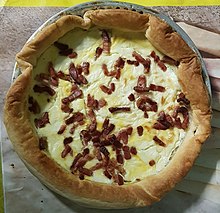Quiche
 Cookbook: Quiche
Cookbook: Quiche-
 Media: Quiche
Media: Quiche
Quiche (/ˈkiːʃ/ KEESH) is a French tart consisting of a pastry crust filled with savoury custard and pieces of cheese, meat, seafood or vegetables. A well-known variant is quiche lorraine, which includes lardons or bacon. Quiche may be served hot, warm or cold.
Overview
Etymology
The word is first attested in French in 1805, and in 1605 in Lorrain patois. The first English usage — "quiche lorraine" — was recorded in 1925. The further etymology is uncertain, but it may be related to the German Kuchen meaning "cake" or "tart".[1]
History

Quiche is a French dish originating from the eastern part of the country. It may derive from an older preparation called féouse[2] typical in the city of Nancy in the 16th century. The early versions of quiche were made of bread dough but today shortcrust and puff pastry are used.[3] In 1586, They were served at a dinner for Charles III, Duke of Lorraine[4]. Before that, recipes for eggs and cream baked in pastry containing meat, fish and fruit are referred to as Crustardes of flesh and Crustade in the 14th-century The Forme of Cury.[5] Since the Middle Ages, there have been local preparations in Central Europe, from the east of France to Austria, that resemble quiche[6].
The American writer and cookery teacher James Peterson recorded first encountering quiche in the late 1960s and being "convinced it was the most sophisticated and delicious thing [he had] ever tasted". He wrote that, by the 1980s, American quiches had begun to include ingredients he found "bizarre and unpleasant", such as broccoli,[n 1] and that he regarded Bruce Feirstein's satirical book Real Men Don't Eat Quiche (1982) as the "final humiliation" of the dish, such that "[a] rugged and honest country dish had become a symbol of effete snobbery".[7]
Varieties
A quiche usually has a pastry crust and a filling of eggs and milk and/or cream. It may be made with vegetables, meat or seafood, and be served hot, warm or cold.[8][9] Types of quiches include:
| Name | Main ingredients | Ref |
|---|---|---|
| Quiche au Camembert | Camembert cheese, cream, eggs | [10] |
| Quiche aux champignons | Mushrooms, cream, eggs | [11] |
| Quiche aux endives | Chicory, cream, eggs, cheese | [12] |
| Quiche aux épinards | Spinach, cream, eggs | [11] |
| Quiche au fromage de Gruyère | Gruyère cheese, cream, eggs, bacon | [13] |
| Quiche aux fromage blanc | Cream cheese, cream, eggs, bacon | [14] |
| Quiche aux fruits de mer | Shrimp, crab or lobster, cream, eggs | [15] |
| Quiche aux oignons | Onions, cream, eggs, cheese | [16] |
| Quiche aux poireaux | Leeks, cream, eggs, cheese | [12] |
| Quiche au Roquefort | Roquefort cheese, cream, eggs | [10] |
| Quiche comtoise | Comté cheese, cream, eggs, smoked bacon | [17] |
| Quiche lorraine | Cream, eggs, bacon[n 2] | [13] |
| Quiche niçoise, à la tomate | Anchovies, olives, tomatoes, eggs, Parmesan cheese | [10] |
In her French Country Cooking (1951), Elizabeth David gives a recipe for a quiche aux pommes de terre, in which the case is made not from shortcrust pastry but from mashed potato, flour and butter; the filling is cream, Gruyère and garlic.[18]
Gallery




See also
Notes
- ^ Peterson's noting his aversion to broccoli echoed earlier remarks by former President George H. W. Bush, who too notably did not like the vegetable.
- ^ Some recipes add cheese, but the traditional Lorrainian version does not.[14]
References
- ^ "quiche". Oxford English Dictionary. OUP. 2015. Retrieved 4 February 2016.
- "Quiche", Centre Nationale de Ressources Textuelles et Lexicales. Accessed 12 February 2015. This source also notes the first reference to 1805, in J.-J. Lionnois, Hist. des villes vieille et neuve de Nancy..., Nancy, t. 1, p. 80 - ^ Hamlyn (2 August 2018). New Larousse Gastronomique. Octopus. ISBN 978-0-600-63587-1.
- ^ Damien Pignolet (13 June 2019). "How to make a goat's cheese and herb quiche". Gourmet Traveller.
- ^ Renauld, Jules Auteur du texte (1875). Les hostelains et taverniers de Nancy : essai sur les moeurs épulaires de la Lorraine / par Jules Renauld,...
- ^ Hieatt, Constance; Butler, Sharon (1985). Curye on Inglysch: English culinary manuscripts of the fourteenth century (including the forme of cury. SS. Vol. 8. London: EETS.
- ^ Germershausen, Christian Friedrich (1782). Die Hausmutter in allen ihren Geschäfften (in German). Junius.
- ^ Peterson, p. 153
- ^ David (2008), pp. 18 and 187
- ^ Beck et al, p. 153
- ^ a b c Beck et al, p. 155
- ^ a b Beck et al, p. 160
- ^ a b Beck et al, p. 159
- ^ a b Beck et al, p. 154
- ^ a b David (2008), p. 187
- ^ Beck et al, p. 156
- ^ Beck et al, p. 157
- ^ Montagné, p. 430
- ^ David (1999), p. 285
Sources
- Beck, Simone; Louisette Bertholle; Julia Child (2012) [1961]. Mastering the Art of French Cooking, Volume One. London: Particular. ISBN 978-0-241-95339-6.
- David, Elizabeth (1999) [1950, 1951, 1955]. Elizabeth David Classics – Mediterranean Food; French Country Cooking; Summer Food (second ed.). London: Grub Street. ISBN 1-902304-27-6.
- David, Elizabeth (2008) [1960]. French Provincial Cooking. London: Folio Society. OCLC 809349711.
- Montagné, Prosper (1976). Larousse gastronomique. London: Hamlyn. OCLC 1285641881.
- Peterson, James (2002). Glorious French Food: A Fresh Approach to the Classics. New York: Wiley. ISBN 978-0-471-44276-9.
External links



- Quiche

















